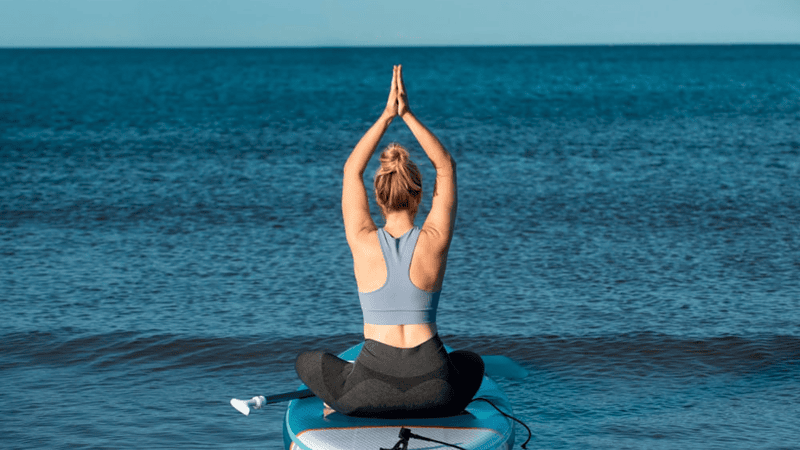Banish Anxiety With Yoga – How to keep smiling even when you can’t breathe…four self-directed yogic tools that can offer instant relief.
By Eryn Kirkwood
According to the World Health Organisation (WHO), anxiety ranks high on the list of the most common mental health disorders worldwide, second only to depression – and rates continue to escalate. Between 1990 and 2013, the number of people suffering from depression and anxiety increased by nearly 50%, from 416 million to 615 million worldwide, with over 5 million cases of anxiety disorder (18.17%) in the UK population alone. A total of 8.2 million cases of anxiety in the UK were reported in 201 3, and in 2014, 1 9.7% of people aged 16 years and over showed symptoms of anxiety or depression.
Although not comfortable, the physiological response to stress that we typically associate with anxiety – sweaty palms, increased heart rate, a burst of adrenalin – serves a purpose in human evolution; a swift reflex can be life-saving in threatening situations. But when those same defence mechanisms don’t subside as the threat of danger recedes, they can wreak havoc on our overall health and wellbeing.
For me, anxiety manifests as a throat restricting, gut-wrenching feeling that makes breathing impossible and functioning even less so. I’ve found myself lying in bed trying to sleep, with my disobedient mind racing from point A to B and back again like wild bees circling a hive. It’s not a fun place to be. But it is, as I discovered, an interesting place to be. And it is also an opportunity for change.
Reel it in
Prior to this sleepless night, I wasn’t worried about my parents dying, the mortgage getting paid, or my old-age security in the absence of any pension. Not a single thing had changed from three in the afternoon until ten at night, when the sun was sinking and those issues grew to a size larger than life. Large enough to keep me awake and worried, full of anxiety, sleepless and preoccupied. It didn’t make sense. I hadn’t been laid off, both parents were alive and well, no tragic circumstance had entered my life. The only thing that was different was my state of mind.
The good news is that just as easily as your mind can go off the deep end, you can quickly reel it back in. That’s where yoga comes in.
Current research has shown the positive impact of yoga and other holistic modalities on wellbeing. Increasing numbers of health practitioners are incorporating these tools into their practice, with positive results. An article published in the March 2017 issue of The Journal of Stress and Coping reported positive results of Yin Yoga on a group of participants suffering from chronic stress. The effect remained present at a five-week follow-up.
Yoga tools
These four self-directed yogic tools can all offer instant relief for those experiencing anxiety:
Breathe Deeply
It is physiologically impossible to be anxious while inhaling and exhaling deeply. Think about it. How do you breathe when you are sobbing and upset? How do you respond to a shocking surprise? What does it mean to “wait with bated breath”? Each of our emotions is directly related to the way in which we breathe. One way to calm a racing mind is to change the nature of our breath. Inhale for a count of four. Exhale for a count of four. Focus your mind on this eight-second count and watch the anxiety subside.
Relax Your Body
Look for areas of tension in your body and soften those muscles. Soften your eyes deep into their sockets. Relax the tiny muscles around your eyes. Smoothen out the skin across the forehead, bridge of the nose, and cheekbones. Then move from the tips of your toes to the crown of your head, methodically relaxing every part of your body. Pay particular attention to where anxiety tends to settle, perhaps in the stomach or throat. Once you become aware of the tendency, you have the ability to reverse it.
Practice Yoga Postures
The ancient yogis were masters at using the body to affect their mind. In our western compartmentalisation of physical illness, we’ve distanced ourselves from this mindbody connection. For example, if I ask you to ‘get angry’ for no reason at all, you might clench your teeth, furrow your brow, or make fists with your hands. This instantly impacts your mood, and not in a good way. Conversely, you can soften your jaw and relax your fingers to encourage a state of calmness. Try practicing Viparita Karani (Legs-up-the-Wall pose), an inverted yoga posture that aids to soothe the nervous system.
Discipline Your Mind
Remember that fear and faith cannot co-exist. Choose one. Choose faith. If you are confident that ‘things will work out’, then there is no room to worry about the outcome. The human mind can only focus on one thing at a time; if you harbour thoughts that provoke anxiety, you won’t enjoy peace of mind. If you choose mantras that have a calming effect, you can banish anxiety and access your inner wisdom. Each passing moment presents an opportunity to choose between fear and faith. If worry has taken your brain hostage, somewhere along the way you’ve lost faith. Reconnect with your spiritual nature through journaling, prayer, uplifting reading, meditation, or yoga.
If you have a legitimate concern, if you’ve received upsetting news or are faced with a difficult situation, consider what you can do about it, right now. If there is something, then take action. If there is nothing, then don’t waste your energy fretting unproductively. Begin to formulate a game plan, a solution; and let yoga be your guide.
Eryn is a full-time writer and yoga teacher living in Ottawa, Canada, and the author of Strong Body, Calm Mind: A Simple Guide to Empowering Your Life with Yoga.
To subscribe to Om Yoga Magazine, Click Here





